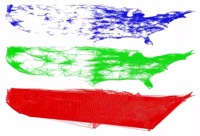Our Model

Multiscale human travel network obtained by observing
the flux of dollar bills in the US.
In our simulations for the spread in the United
States we take Mexico City to be the starting point of the
infection. The initial conditions of the model are chosen
to match the available information on confirmed cases in
the United States and Mexico, and we permit for a bracket
of unconfirmed cases. We take into account the travel of
individuals between counties in the United States and the
incoming flux of airline passengers from Mexico City. We
consider a worst-case scenario based on assumptions made
from the information we have gathered thus far. The key
factors in our modeling approach are very accurate human
mobility datasets on scales from a few to a few thousand
kilometers. We obtained the underlying multi-scale human
mobility network indirectly by our recent investigation on
the
geographic
circulation of dollar bills in the United States,
which is an excellent proxy for human mobility and
includes small scale daily commuting traffic,
intermediate traffic, and long distance travel by air.
Our simulations consist of multiple layers, each layer
possessing and increasing degree of accuracy and
complexity. Our final projections are done with a
fully stochastic model that incorporates the inherent
randomness in disease dynamics that is particularly
important at the onset of an epidemic when the number
of infected individuals is small compared to the whole
population.

